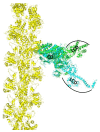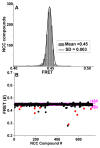Actin-Myosin Interaction: Structure, Function and Drug Discovery
- PMID: 30189615
- PMCID: PMC6163256
- DOI: 10.3390/ijms19092628
Actin-Myosin Interaction: Structure, Function and Drug Discovery
Abstract
Actin-myosin interactions play crucial roles in the generation of cellular force and movement. The molecular mechanism involves structural transitions at the interface between actin and myosin's catalytic domain, and within myosin's light chain domain, which contains binding sites for essential (ELC) and regulatory light chains (RLC). High-resolution crystal structures of isolated actin and myosin, along with cryo-electron micrographs of actin-myosin complexes, have been used to construct detailed structural models for actin-myosin interactions. However, these methods are limited by disorder, particularly within the light chain domain, and they do not capture the dynamics within this complex under physiological conditions in solution. Here we highlight the contributions of site-directed fluorescent probes and time-resolved fluorescence resonance energy transfer (TR-FRET) in understanding the structural dynamics of the actin-myosin complex in solution. A donor fluorescent probe on actin and an acceptor fluorescent probe on myosin, together with high performance TR-FRET, directly resolves structural states in the bound actin-myosin complex during its interaction with adenosine triphosphate (ATP). Results from these studies have profound implications for understanding the contractile function of actomyosin and establish the feasibility for the discovery of allosteric modulators of the actin-myosin interaction, with the ultimate goal of developing therapies for muscle disorders.
Keywords: ATP; FRET; actin; drug discovery; fluorescence; heart failure; myosin.
Conflict of interest statement
D.D.T. holds equity in, and serves as President of, Photonic Pharma LLC. This relationship has been reviewed and managed by the University of Minnesota. Photonic Pharma had no role in this study.
Figures






Similar articles
-
High-throughput screen, using time-resolved FRET, yields actin-binding compounds that modulate actin-myosin structure and function.J Biol Chem. 2018 Aug 3;293(31):12288-12298. doi: 10.1074/jbc.RA118.002702. Epub 2018 Jun 4. J Biol Chem. 2018. PMID: 29866882 Free PMC article.
-
Amplitude of the actomyosin power stroke depends strongly on the isoform of the myosin essential light chain.Proc Natl Acad Sci U S A. 2015 Apr 14;112(15):4660-5. doi: 10.1073/pnas.1420101112. Epub 2015 Mar 30. Proc Natl Acad Sci U S A. 2015. PMID: 25825773 Free PMC article.
-
A Cardiomyopathy Mutation in the Myosin Essential Light Chain Alters Actomyosin Structure.Biophys J. 2017 Jul 11;113(1):91-100. doi: 10.1016/j.bpj.2017.05.027. Biophys J. 2017. PMID: 28700929 Free PMC article.
-
Changes in actin and myosin structural dynamics due to their weak and strong interactions.Results Probl Cell Differ. 2002;36:7-19. doi: 10.1007/978-3-540-46558-4_2. Results Probl Cell Differ. 2002. PMID: 11892285 Free PMC article. Review.
-
How Myosin Generates Force on Actin Filaments.Trends Biochem Sci. 2016 Dec;41(12):989-997. doi: 10.1016/j.tibs.2016.09.006. Epub 2016 Oct 4. Trends Biochem Sci. 2016. PMID: 27717739 Free PMC article. Review.
Cited by
-
Role of Cyclins and Cytoskeletal Proteins in Endometriosis: Insights into Pathophysiology.Cancers (Basel). 2024 Feb 19;16(4):836. doi: 10.3390/cancers16040836. Cancers (Basel). 2024. PMID: 38398227 Free PMC article. Review.
-
Affordable mRNA Novel Proteins, Recombinant Protein Conversions, and Biosimilars-Advice to Developers and Regulatory Agencies.Biomedicines. 2025 Jan 3;13(1):97. doi: 10.3390/biomedicines13010097. Biomedicines. 2025. PMID: 39857681 Free PMC article. Review.
-
Overexpression of Myo1e promotes albumin endocytosis by mouse glomerular podocytes mediated by Dynamin.PeerJ. 2020 Mar 17;8:e8599. doi: 10.7717/peerj.8599. eCollection 2020. PeerJ. 2020. PMID: 32211226 Free PMC article.
-
Comparative analysis of methods to reduce activation signature gene expression in PBMCs.Sci Rep. 2023 Dec 28;13(1):23086. doi: 10.1038/s41598-023-49611-2. Sci Rep. 2023. PMID: 38155174 Free PMC article.
-
Purification of sarcoplasmic reticulum vesicles from horse gluteal muscle.Anal Biochem. 2020 Dec 1;610:113965. doi: 10.1016/j.ab.2020.113965. Epub 2020 Sep 19. Anal Biochem. 2020. PMID: 32956693 Free PMC article.
References
-
- Thomas D.D., Muretta J.M., Colson B.A., Mello R.N., Kast D. Spectroscopic Probes of Muscle Proteins. In: Edward H.E., editor. Comprehensive Biophysics. Elsevier; Amsterdam, The Netherlands: 2012. pp. 226–250.
Publication types
MeSH terms
Substances
Grants and funding
LinkOut - more resources
Full Text Sources
Other Literature Sources

